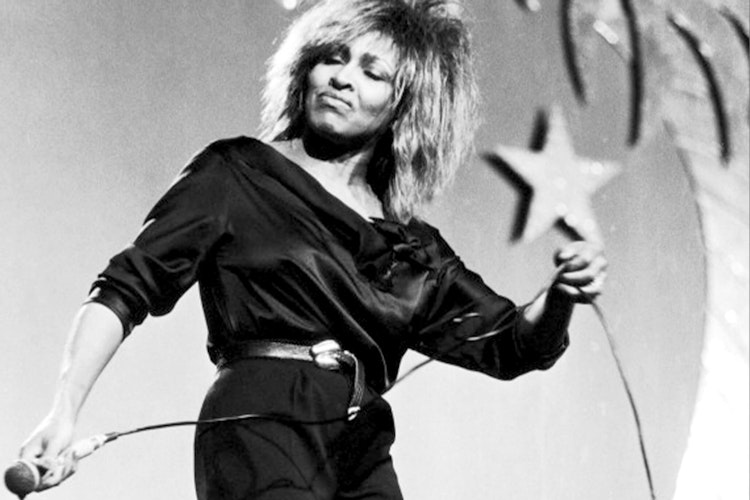In this article, we celebrate Black artists and individuals who were influential in shaping Rock music and popular music more broadly speaking. These particular individuals started their careers in the mid 50s through the early 60s, starting with Diana Ross and The Supremes and ending with Larry Graham.
Don’t forget to review all of our other artist lists.
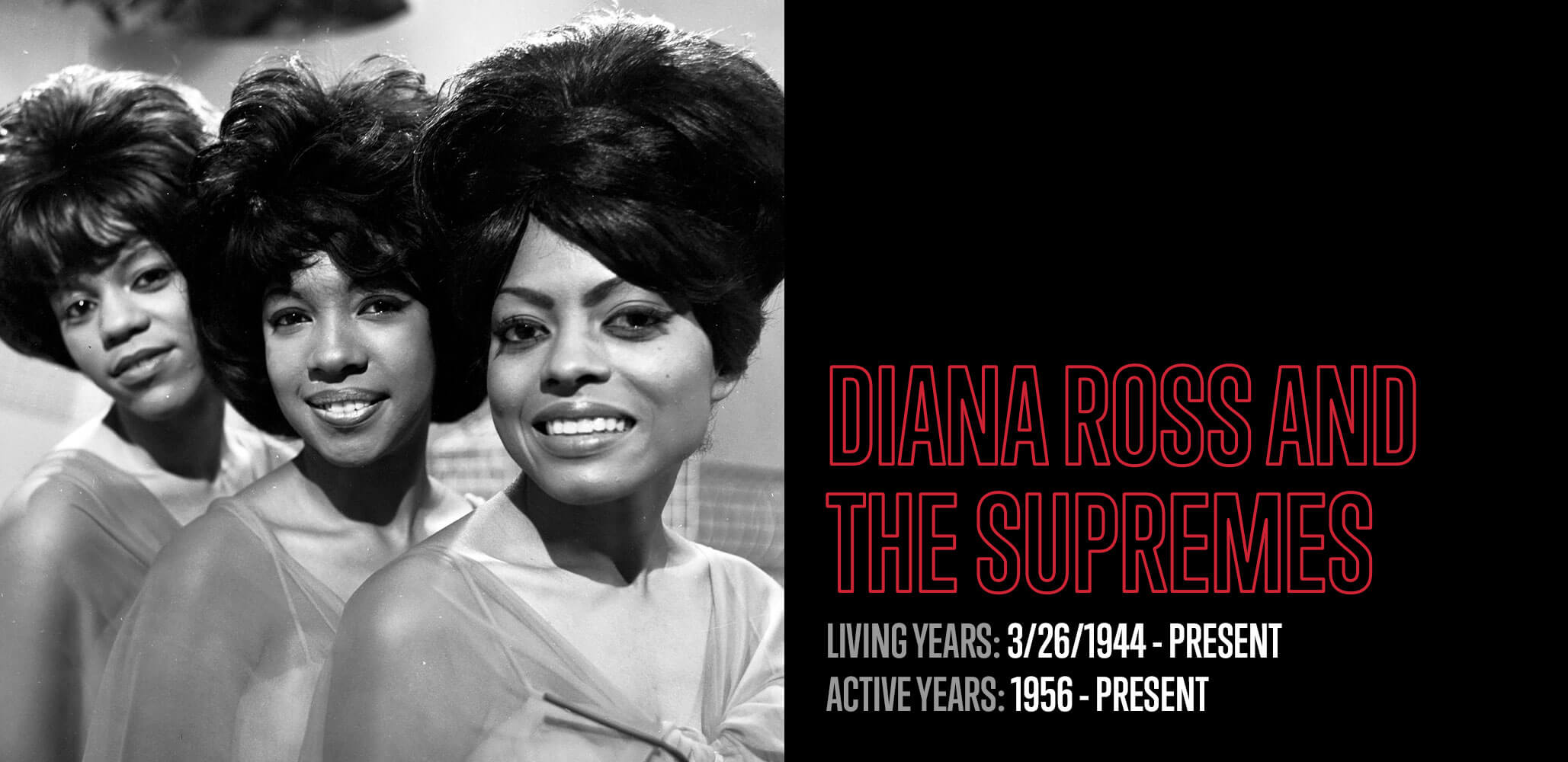
Instrument
Vocals
Genres
R&B, Soul, Pop
Notable Songs
Where Did Our Love Go, Baby Love, Ain’t No Mountain High Enough
Associated Artists/Acts
The Supremes, Michael Jackson
Biography
Diana Ross is one of the most successful female musical artists of all time, scoring number one hits with The Supremes and as a solo artist. Diana Ross and The Supremes were Motown’s most successful act and they were the most successful “Girl Group” of all time.
Born in Detroit, Michigan in 1944, Ross joined an all-girl group the Primettes in 1958. They auditioned for Motown, but label head Berry Gordy thought the girls were too young and still needed to finish high school. In 1961 Berry relented and signed the group but had them change their name to The Supremes. The lineup was Ross, Mary Wilson and Florence Ballard. Initially, all three took turns as the lead vocalist. They released several singles but they failed to gain any traction. In 1963, Gordy decided that Ross should be the lead singer and the focal point of the group.
In 1964, Diana Ross and The Supremes began their domination of the charts. “Where Did Our Love Go” was the first of five consecutive Number One hits followed by “Baby Love”, “Come See About Me”, “Stop (In the Name of Love)” and “Back In My Arms Again”. All five songs were written by the team of Holland-Dozier-Holland, who were the top songwriters and producers for Motown. The next year, The Supremes released three more Holland-Dozier-Holland penned Number Ones: “I Hear a Symphony”, “You Can’t Hurry Love” and “You Keep Me Hangin’ On”.
The Supremes were Motown’s flagship act and their polished look and smooth performances made them popular with both Black and white fans. Gordy groomed The Supremes (and his other acts), presenting them as a full package. In 1967, Gordy also changed the name of the group from The Supremes to Diana Ross and The Supremes. Behind the scenes there was turmoil as Florence Ballard was not accepting her role as a “backup” singer to Ross. Ballard was replaced by one of Patti LaBelle’s back up singers, Cindy Birdsong, in 1967. Tensions within the band and at Motown continued and Ross left The Supremes in 1970.
Diana Ross began a highly successful solo career and she also branched out into film. “Ain’t No Mountain High Enough” was her first solo number one hit. She starred in the film Lady Sings the Blues, based on Billie Holiday’s life story. She continued to have hits, such as her duet with Lionel Richie “Endless Love”, her last number one.
As a member of The Supremes, Ross was inducted into the Rock and Roll Hall of Fame in 1988. Her work with The Supremes and as a solo artist influenced everyone from Michael Jackson to Beyoncé, making her one of the most influential, as well as successful, female artists of all time.
Historical or Cultural Context
One of the best-selling female vocal groups of all time
Artists/Acts They Influenced
The Jackson 5, Beyoncé, Mariah Carey
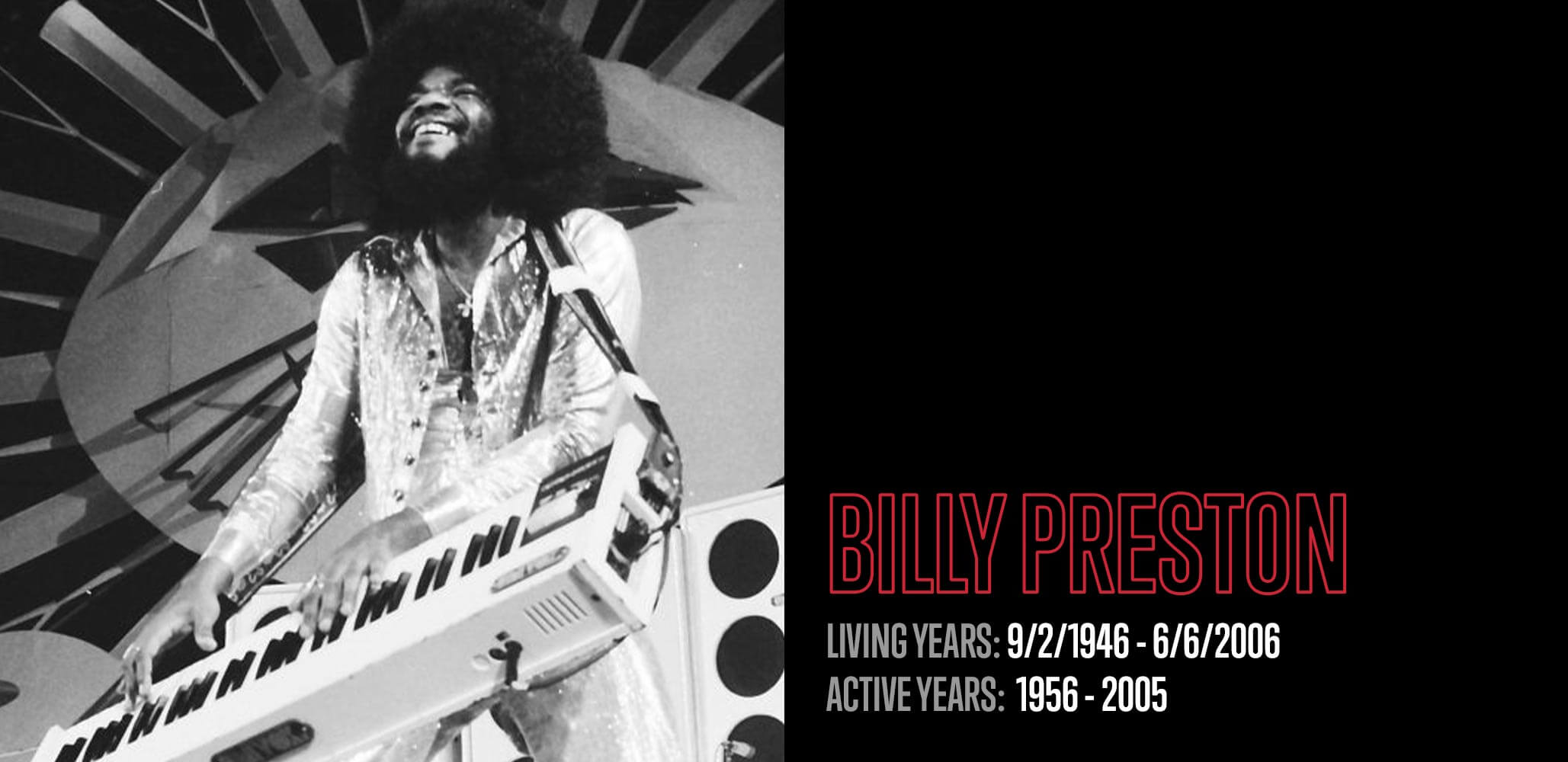
Instruments
Keyboards, vocals
Genres
R&B, Rock, Soul, Funk, Gospel
Notable Songs
Get Back, Nothing From Nothing, Don’t Let Me Down, Will It Go Round in Circles
Associated Artists/Acts
The Beatles, The Rolling Stones, Ray Charles, Sam Cooke, Little Richard
Biography
Billy Preston’s career as an artist and musician spans over five decades. He was a top session keyboardist in the 1960s, where he played for artists like Little Richard, Sam Cooke, Ray Charles, the Everly Brothers, the Rolling Stones, and the Beatles.
Billy is widely known as the “Fifth Beatle,” having been one of the only other musicians besides the Beatles themselves to be credited on some of their albums such as Let It Be and Abbey Road and the White Album. In the late 60s Billy worked with John Lennon and Yoko Ono on their solo album Plastic Ono Band, with Ringo Starr on his solo single “Oh My My”, and with George Harrison on his American tour.
Preston also had much success as a solo artist and scored a string of number one hit singles, including the Grammy-winning “Outa-Space”, “Will It Go Round in Circles”, “Nothing From Nothing” and “Space Race”. Preston was a prolific writer as well, penning the multi-platinum standard “You Are So Beautiful” which was famously performed by Joe Cocker. Preston also wrote the title songs for a series of box office hit movies and even co-wrote the score for the movie They Call Me Mr. Tibbs with Quincy Jones.
More recently, Billy Preston was the first Black musical director of a late night television show, Nightlife, and was a regular on the UPN series Good News. He also made a cameo appearance in Blues Brothers 2000 as part of the supergroup that included Eric Clapton, Stevie Winwood and B.B. King, among others. Preston recorded on Ray Charles’ final album, on the Red Hot Chilli Pepper’s song “Warlocks”, and on the Neil Diamond album 12 Songs. Billy suffered from kidney disease and pericarditis and passed away on June 6, 2006, from respiratory failure.
ARTISTS/Acts he influenced
The Beatles, The Rolling Stones, Miles Davis, Elton John
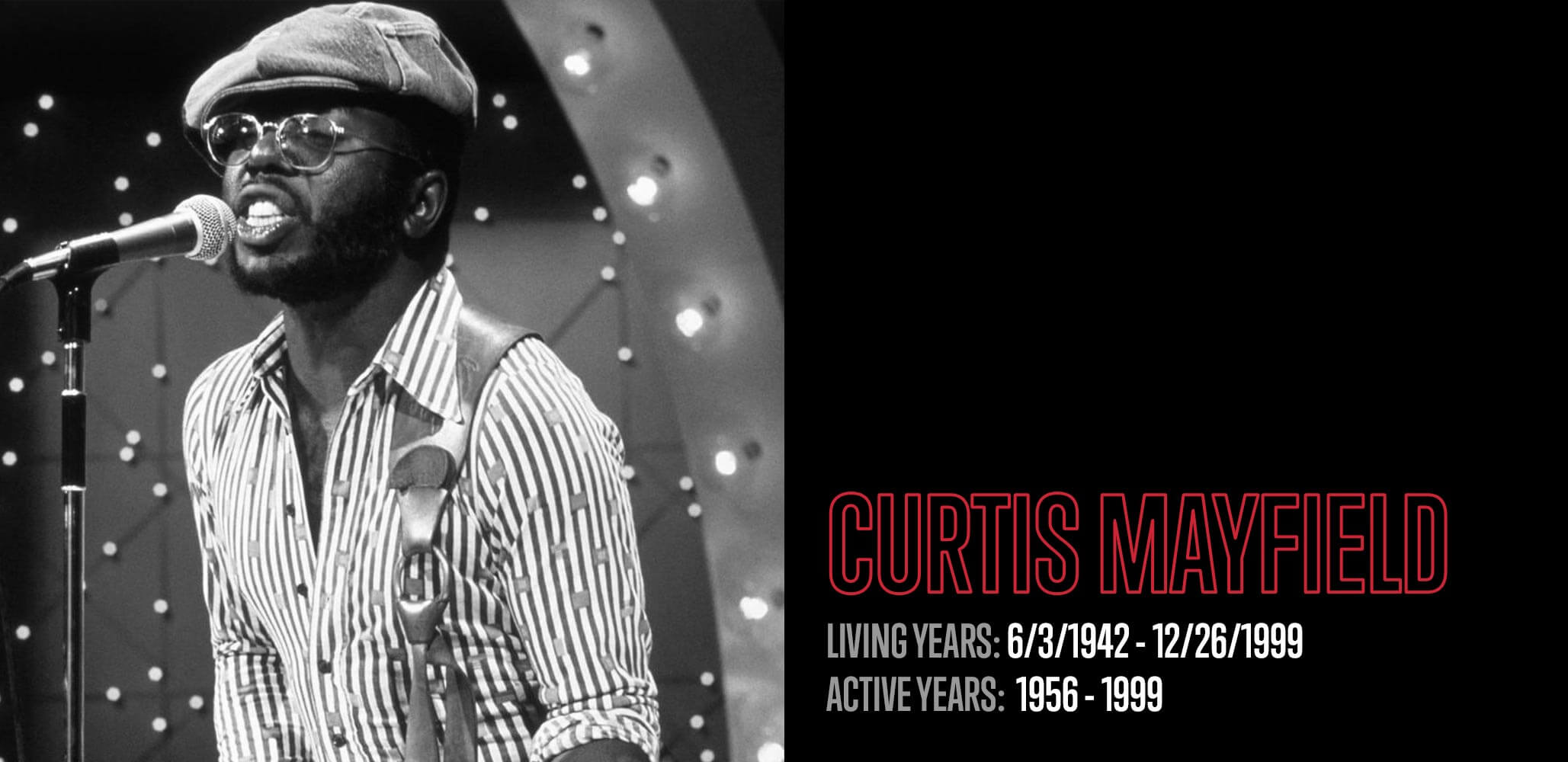
Instruments
Guitar, vocals
Genres
Soul, R&B
Notable Songs
Keep on Pushin, People Get Ready, Freddie’s Dead
Associated Artists/Acts
The Impressions
Biography
One of the most important figures in American popular music, Curtis Mayfield was born in 1942 in Chicago, Illinois. He is known for his distinctive falsetto vocals and a unique guitar style, but most of all he is known for his socially conscious lyrics and positive message.
Mayfield taught himself to play guitar as a child and sang in church. In high school he met Jerry Butler and they began singing and playing in a band together. Two years later in 1958, that band became The Impressions. The Impressions soon had hits with “It’s Alright” and “Gypsy Woman,” but gained prominence in 1964 with the Mayfield-penned “Keep On Pushin”, which was adopted as an anthem by the Civil Rights Movement. Mayfield also wrote The Impressions’ biggest hit, “People Get Ready”, which was inspired by Martin Luther King's March on Washington.
In 1970, Mayfield left The Impressions and became a solo artist. His solo records continued to be socially conscious and have a message of unity. He hit his creative and popular peak with the soundtrack to the 1972 blaxploitation film Super Fly. Super Fly was hugely successful and Mayfield’s soundtrack sent a message about the dangers of drugs with songs such as “Freddie’s Dead” and “Pusherman”.
In 1990, Mayfield was paralyzed from the neck down after a lighting rig fell on him during a concert. Despite the accident, he continued to record and released another album in 1996. Mayfield is a two-time inductee in the Rock and Roll Hall of Fame, having been inducted in 1991 as part of The Impressions and again in 1999 as a solo artist. Mayfield passed away on December 26, 1999.
Historical or Cultural Context
Wrote civil rights anthems and blaxploitation soundtracks
Artists/Acts He Influenced
Prince, Marvin Gaye, Stevie Wonder, Jimi Hendrix, Rod Stewart
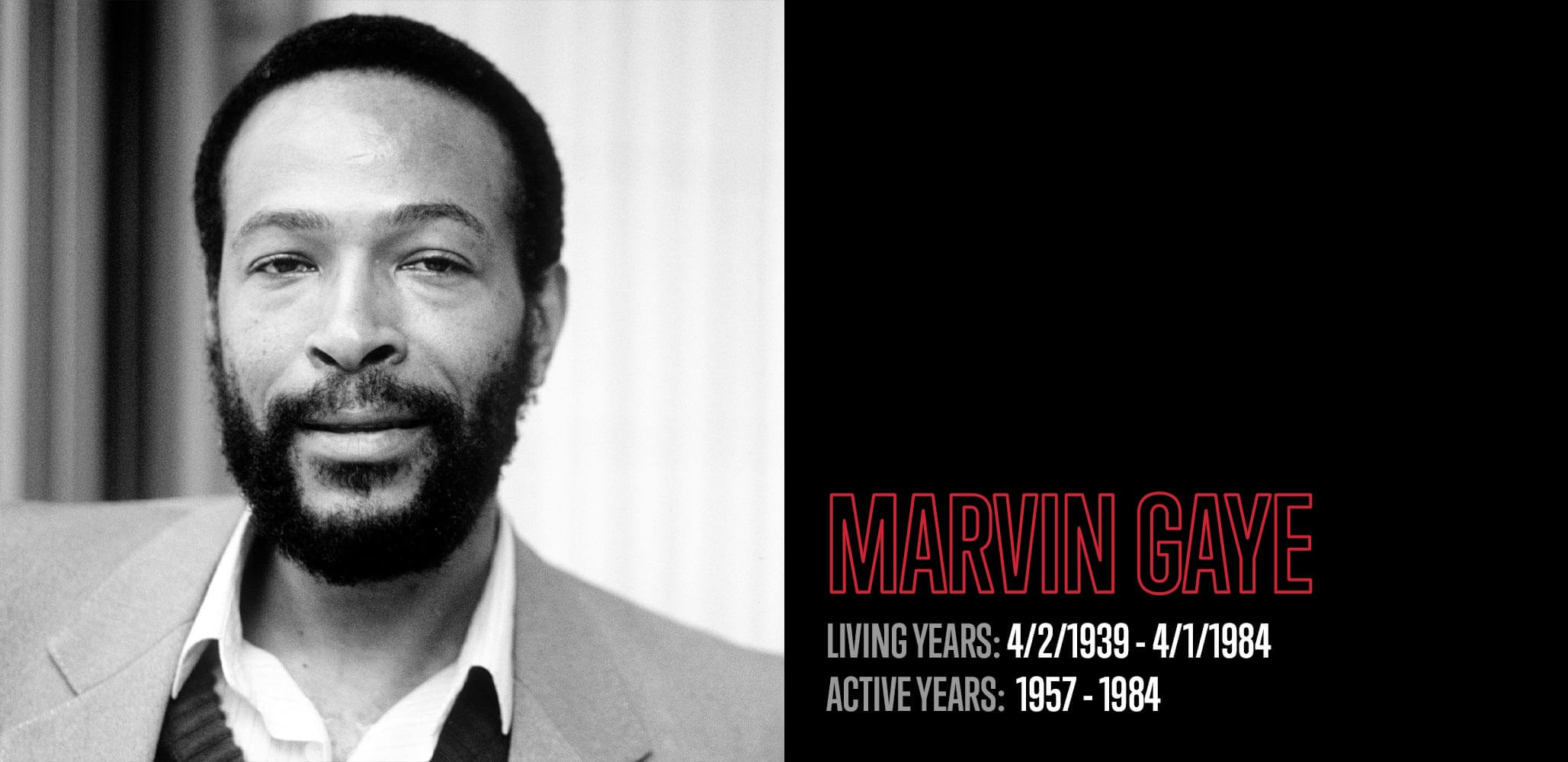
Instruments
Vocals, drums, piano
Genres
R&B, Soul, Funk
Notable Songs
It Takes Two, Ain’t No Mountain High Enough, I Heard It Through the Grapevine, What’s Going On, Let’s Get It On
Associated Artists/Acts
Tammi Terrell, Bo Diddley, Harvey Fuqua, Mary Wells, Kim Weston
Biography
Marvin Gaye was an R&B and Soul legend. A singer with a huge range and astounding versatility, an accomplished drummer, and a songwriter who was equally adept writing charged political anthems as he was writing funky tributes to romance.
Gaye was born in the projects in Washington DC in 1939 and began singing in church as a small child. His father was violent and abusive, and Gaye found singing to be an outlet for his anxiety and depression. After a short stint in the Air Force and early R&B spinoff group The New Moonglows, he moved to Detroit and eventually caught the ear of Motown’s Berry Gordy, who signed him to Motown’s Tamla imprint. Gaye cut his teeth as a session drummer and songwriter for Motown, before finding some success as a solo recording artist. However, it was a series of duets with Mary Wells, “How Sweet It Is (To Be Loved By You)”, Kim Weston, “It Takes Two” and finally Tammi Terrell, “Ain’t No Mountain High Enough” and “Ain’t Nothing Like the Real Thing” that truly jumpstarted Gaye’s career. In 1968, he had his first number one hit with “I Heard It Through the Grapevine”.
In the early 1970s, Marvin Gaye’s songwriting took on a far more political tone, and he found massive success with the title track of his landmark album What’s Going On, a conceptual Soul album that dealt with themes of war, poverty, police brutality, and environmentalism. The album became Motown’s most successful release at the time, and is widely regarded as one of the best Rock and Roll albums ever recorded. Gaye followed that album with one that became even more successful, 1973’s Let’s Get It On, which combined Soul and Funk with Gaye’s seductive vocals to become one of the most influential R&B records of all time, ushering in the era of the “slow jam”.
Through the rest of the 1970s and early 1980s, Marvin Gaye released several more successful recordings, including the number one hits “Got To Give It Up” and “Sexual Healing”. He died in 1984, the day before his 45th birthday, killed in a violent domestic dispute with his father. While Gaye struggled throughout his life with depression and substance abuse, he always approached music as a way to bring redemption and joy to life, and paved the way for legions of artists who came after him. He was inducted into the Rock and Roll Hall Fame in 1987. The United States Postal Service honored Marvin Gaye in 2019 with a postage stamp commemorating his enormous contributions to American culture and music.
Historical or Cultural Context
Prince of Soul, soul pioneer, celebrated songwriter, outspoken on a variety of issues such as war, poverty, police brutality, and the environment
Artists/Acts He Influenced
Barry White, Lionel Richie, Rick James, Prince, D’Angelo, Pharrell Williams, Michael McDonald, Mary J. Blige
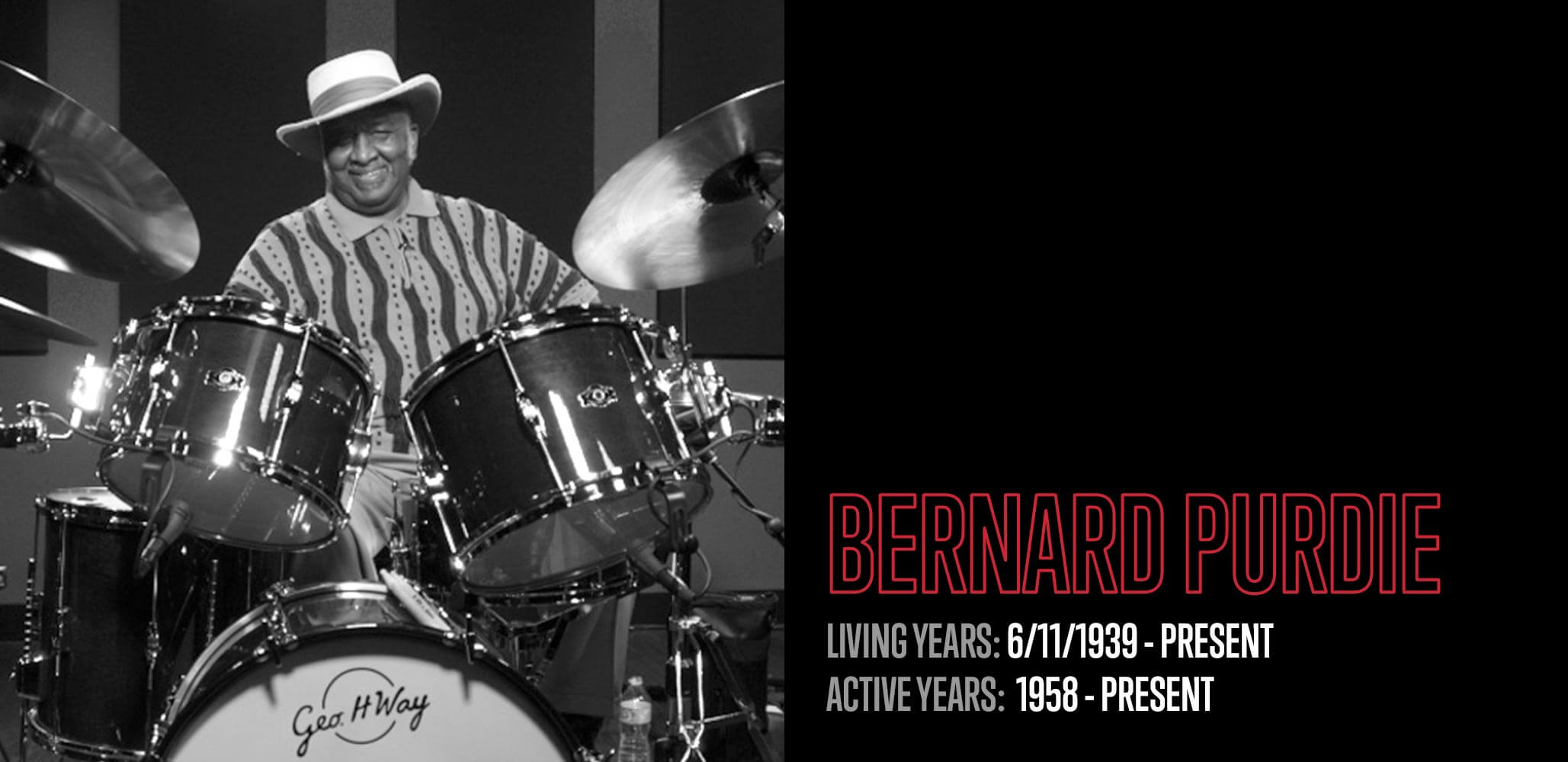
Instrument
Drums
Genres
Soul, Funk, Rock and Roll
Notable Songs
Kid Charlemagne, Rock Steady, The Thrill Is Gone
Associated Artists/Acts
Steely Dan, James Brown, B.B. King, Aretha Franklin, Jeff Beck, Rolling Stones, many more
Biography
Bernard “Pretty” Purdie was born in 1939 in Elkton, Maryland. He picked up the drums as a boy and was soon playing gigs. In the early 60’s he moved to New York and began doing session work. Famous for his signature “Purdie Shuffle”, Bernard is one of the most influential drummers to ever lay down a groove.
During his storied career, Bernard recorded and performed with thousands of artists including Aretha Franklin, James Brown, B.B. King and Steely Dan. Along with Hal Blaine and Earl Palmer, Bernard is one of the most recorded drummers of all time. His style has influenced countless drummers including Led Zeppelin’s John Bonham and Toto’s Jeff Porcaro (who was also a highly sought after studio drummer). “Fool in the Rain” and “Rosanna” are two great examples of other drummers playing variations of the Purdie Shuffle. Bernard’s best known songs include “Rock Steady” by Aretha Franklin, “Kid Charlemagne” by Steely Dan, James Brown’s “It’s a Man’s, Man’s, Man’s World” and “She’s Gone” by Hall and Oates.
Bernard is still actively playing, recording and conducting workshops. His influence can be seen in modern bands such as Vulfpeck and Galactic, as well as just about any band that has played a half-time shuffle.
Technical Innovations
Developed the Purdie Shuffle
Historical or Cultural Context
One of the most recorded drummers of all time
Artists/Acts He Influenced
Toto, Led Zeppelin, The Police
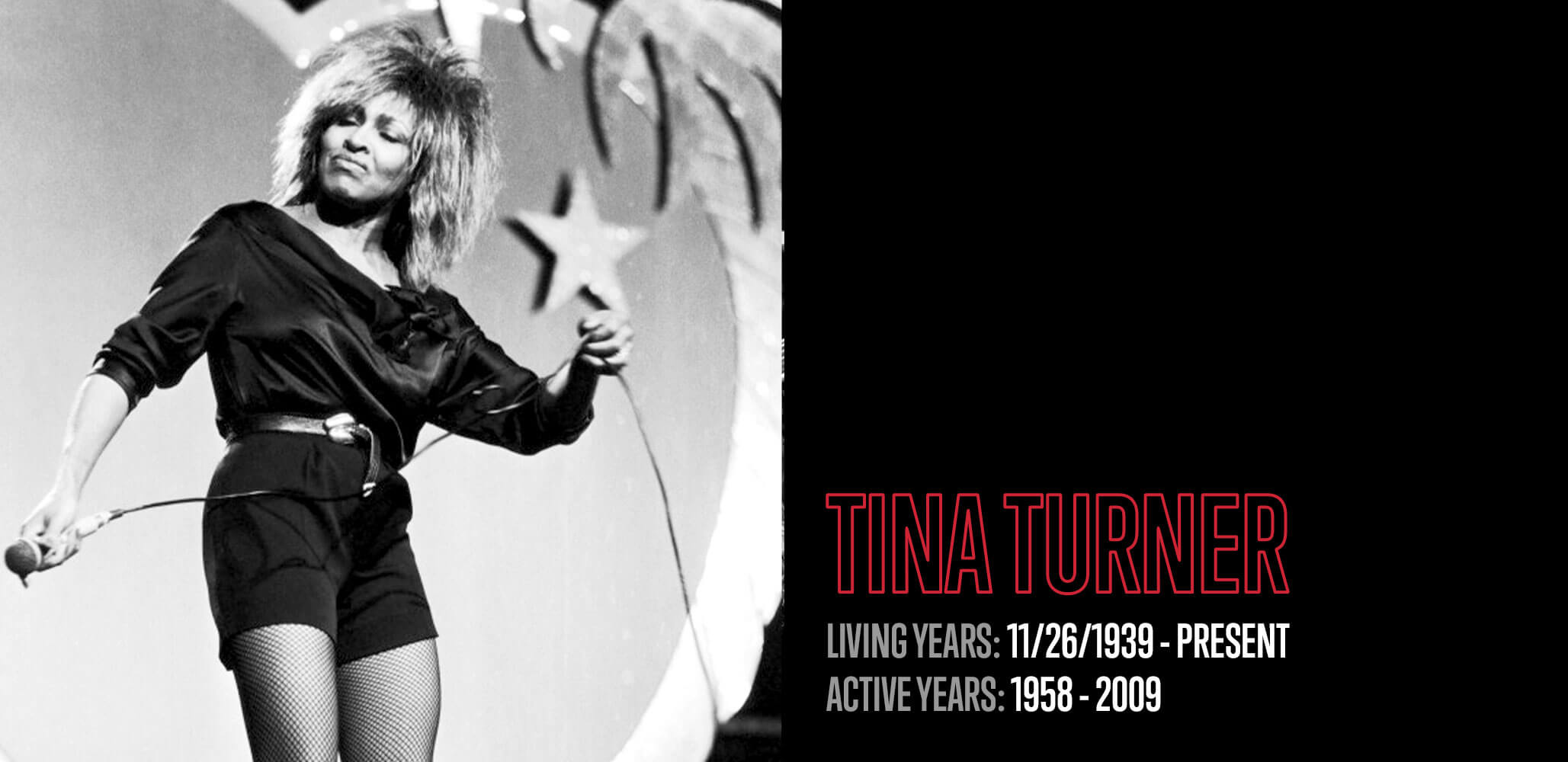
Instrument
Vocals
Genres
Rock and Roll, Blues, Disco, R&B
Notable Songs
Proud Mary, Nutbush City Limits, What’s Love Got To Do With It
Associated Artists/Acts
Ike and Tina Turner, David Bowie, Bryan Adams, Mick Jagger
Biography
Born Anna Mae Bullock, Tina Turner overcame humble beginnings and an abusive marriage to become the Queen of Rock and Roll. Born in Brownsville, Tennessee, the daughter of sharecroppers, she helped her family by picking cotton when she was young. She got started singing in church in Nutbush, Tennessee. As a teenager she moved to St. Louis to live with her sisters and stepmother. She and her sisters used to go to nightclubs after work.
While out at one of these nightclubs she met Ike Turner. Tina sat in with Ike’s band one night and soon after started her personal and professional relationship with Ike, changing her name to Tina Turner. In 1960, Ike and Tina Turner had their first hit single with “Fool in Love". With “Ike and Tina Turner”, Tina released hits like “Nutbush City Limits” and her iconic version of Creedence Clearwater Revival’s “Proud Mary”.
In the mid 70s, Ike and Tina Turner divorced. Tina cited irreconcilable differences and domestic abuse. She started her solo recording career in 1983 and gave us hits like “What’s Love Got To Do With It” and “Private Dancer”. She’s had collaborations with David Bowie, Bryan Adams, and Mick Jagger, and is more recently enjoying success with modern DJ remixes of “What’s Love Got To Do With It”.
Tina Turner was inducted into the Rock and Roll Hall of Fame in 1991 and has won Grammys for Best Female Vocal Performance, Best Solo Performance, and Best Album, among others. She has paved the way for strong female vocalists of every genre.
Historical or Cultural Context
In a time where a lot of white artists were making Black music popular with crossover hits, Ike and Tina did the opposite when they covered Proud Mary
Artists/Acts She Influenced
Beyoncé, Whitney Houston, Mariah Carey
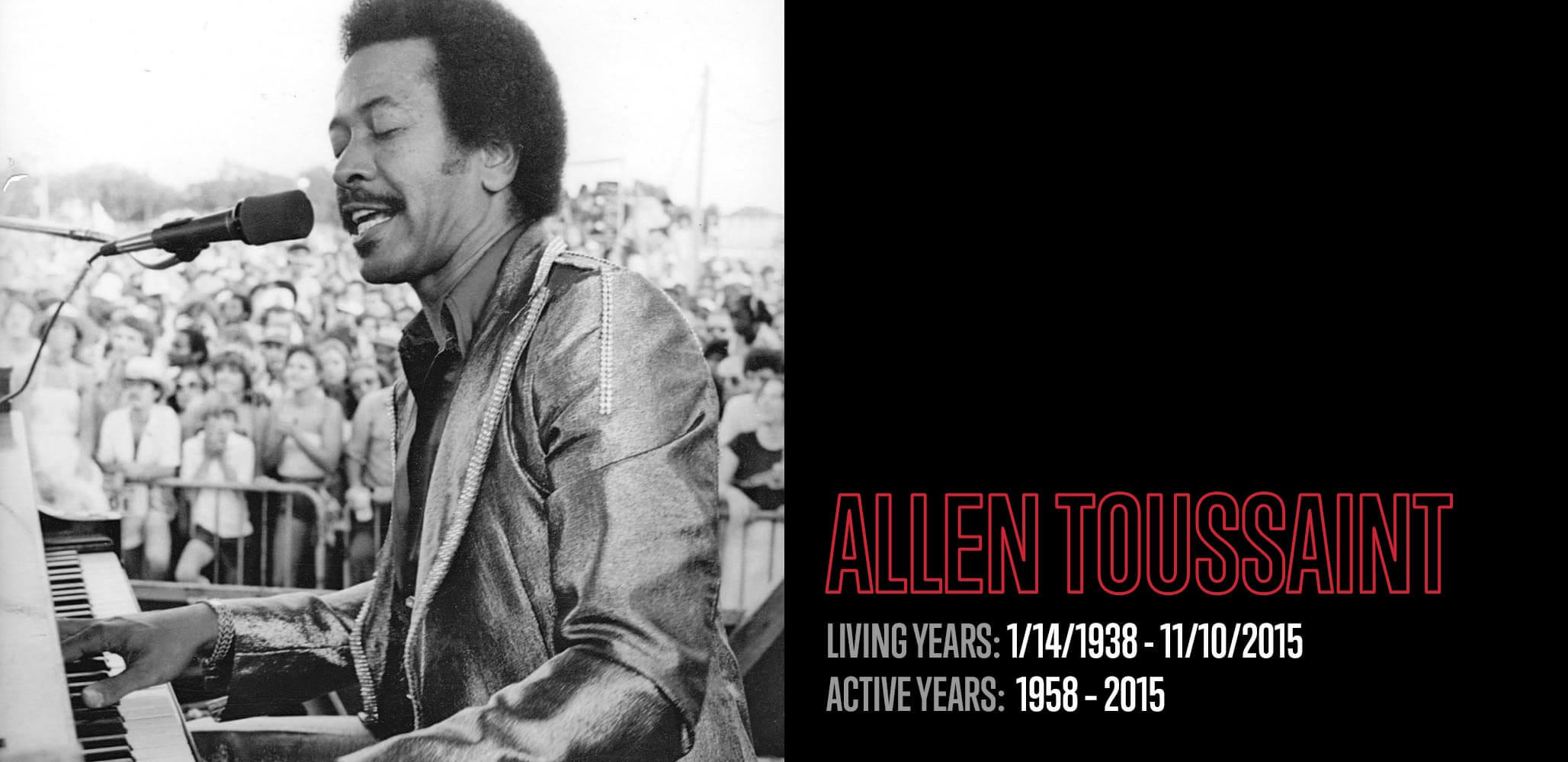
Instruments
Piano, vocals
Genres
Soul, Funk, R&B
Notable Songs
Mother-In-Law, Working in a Coal Mine, Yes We Can, Southern Nights
Associated Artists/Acts
Dr. John, Lee Dorsey, Ernie K-Doe, Elvis Costello, The Band
Biography
While he may not be as well known outside New Orleans, Allen Toussaint is one of the most important and influential figures in Rock and Roll. A pianist, producer, songwriter and performer, Toussaint had his hand in nearly all aspects of the “New Orleans Sound.” Toussaint was able to connect the New Orleans Second Line sound to Rock and Roll.
Born in New Orleans in 1938, Toussaint began playing gigs as a teenager. He was heavily influenced by Professor Longhair. He was quickly noticed and was brought in to play on a Fats Domino session by famed producer Dave Bartholomew. In 1958 he was signed to RCA Records under the name Al Tousan. His instrumental record The Wild Sound of New Orleans contained his composition “Java” that was a #1 hit for trumpeter Al Hirt. Soon Toussaint became a leading force in New Orleans music, writing hit songs such as “Mother-In-Law”, “A Certain Girl”, “Working in a Coal Mine”, “Ruler of My Heart”, “Yes We Can Can” and “Southern Nights”. In 1965, he formed the record label Sansu, whose core group of studio musicians would later be known as the proto-Funk band The Meters. He also produced hits such as Dr. John’s “Right Place, Wrong Time” and Labelle’s “Lady Marmalade”.
While he was primarily a songwriter, arranger and producer, Toussaint began to perform live more in the later years of his career. In 2013, Toussaint was awarded the National Medal of Arts by President Obama. He died after a performance in Spain in 2015 and left one of Rock and Roll’s richest musical legacies. Like a Rock and Roll Forrest Gump, Toussaint always seemed to be in the right place at the right time and had his finger on the Soul of New Orleans.
Artists/Acts They Influenced
Rolling Stones, The Meters, Otis Redding, Boz Scaggs, The Who, Little Feat
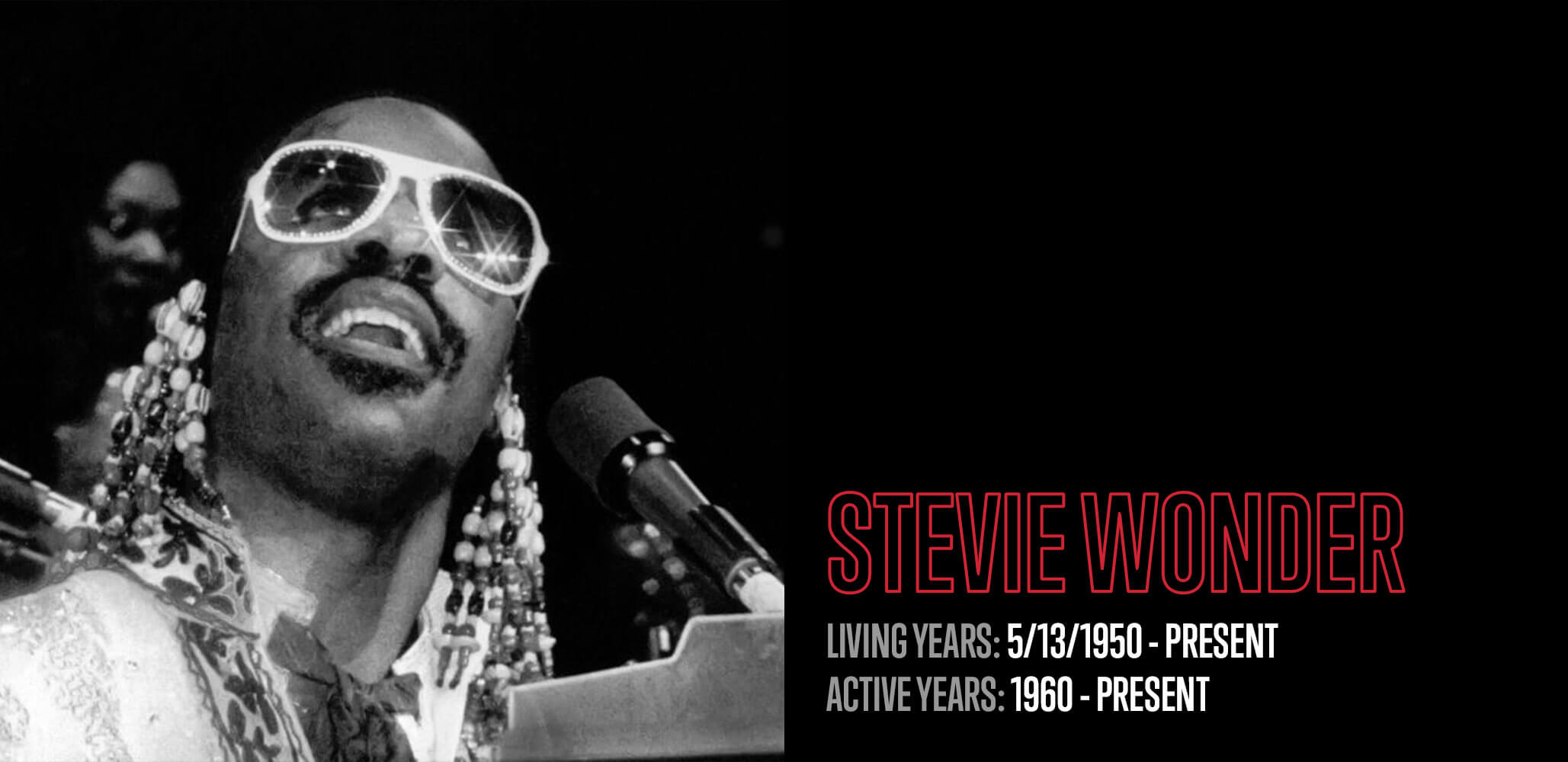
Instruments
Keyboard, vocals, drums, harmonica
Genres
R&B, Gospel, Funk, Soul, Jazz
Notable Songs
Superstition, For Once in My Life, Isn’t She Lovely, Living for the City
Associated Artists/Act
Michael Jackson, Quincy Jones, Dionne Warwick, The Rolling Stones, Sting, Paul McCartney, Whitney Houston, Herbie Hancock, Wyclef Jean, Beyoncé, Busta Rhymes, Snoop Dogg, Ariana Grande
Biography
Stevland Morris (Hardaway) Judkins was born May 13, 1950 in Saginaw, Michigan. Stevie’s blindness was a result of an incident at the hospital when he was born six weeks premature. A high dosage of oxygen was administered in his incubator and he ended up suffering from ROP (retinopathy of prematurity) which is a type of scarring of the eyes. At age 7, his parents divorced, and his mother moved him and his siblings to Detroit, where Stevie sang in the Whitestone Baptist Church, although he was later kicked out of the choir because someone overheard him singing Rock and Roll! His community supported his musical ambitions by giving him instruments. He was a child prodigy, playing drums, piano, and harmonica, and he listened to the radio and sang at an early age. He and his friend John sang at parties and dances, and on street corners to start out.
Little Stevie Wonder’s career took off at age 11 when he met Berry Gordy of Motown Records, who recognized his talent even at such a young age. At 13 years old, he was the youngest artist ever to have a number one hit on the Billboard Hot 100 with the song “Fingertips Part 2”.
One of Wonder’s great musical influences was the use of technology in music. In the 1970’s, Wonder became increasingly interested in synthesizers. Inspired by Tonto’s Expanding Band Head, Wonder was one of the first R&B artists to include synth sounds in his songs like “Living for the City”. The prominent use of the Fender Rhodes keyboard as well as the Hohner Clavinet was heard during this time. Stevie’s song “Superstition” features layered tracks of clavinet and helped popularize the instrument’s use in Funk music.
In the 1970s and 1980s, there were very few musicians who were as successful as Stevie Wonder. He released eight consecutive albums that reached the Top 5 on the Billboard charts, and his albums Music of My Mind, Talking Book, Innervisions, Fulfillingness' First Finale, and Songs in the Key of Life are all regarded as masterpieces. Stevie frequently played most, if not all, of the instruments on his recordings, and blended numerous influences including Soul, Jazz, Rock, Reggae, Jazz and Gospel into something immediately recognizable as his own.
Stevie Wonder was an activist for numerous causes throughout his career, and he did not shy away from writing material that discussed themes like systemic racism, drug abuse, and political corruption. In 1980, he released “Happy Birthday”, a song written to raise awareness for the campaign to make Dr. Martin Luther King Jr.’s birthday a national holiday. Wonder was also a key contributor to “We Are the World”, a supergroup recording in 1985 which raised money for famine relief for the people of Ethiopia.
One of the most well-respected and influential artists in the world, Stevie Wonder has received many high honors over the course of his career. He has sold more than 100 million albums worldwide, and won 25 Grammy Awards. He is a member of the Rock and Roll Hall of Fame and the Songwriters Hall of Fame. He received a Lifetime Achievement Award from the National Civil Rights Museum, and was awarded a Presidential Medal of Freedom by Barack Obama in 2014. In 2007, the United Nations named Stevie Wonder a Messenger of Peace, honoring his goodwill and world-changing contributions to the arts.
Technical Innovations
One of the first artists to incorporate electronic and synth technology into his music
Historical or Cultural Context
He wanted to use his music to express his support of the Civil Rights Movement. Helped petition to make Dr. Martin Luther King Jr’s birthday a federal holiday.
Artists/Acts He Influenced
D’Angelo, John Legend, Esperanza Spalding, Erykah Badu, Jamiroquai, and countless others

Instrument
Vocals
Genres
R&B, Rock
Notable Songs
Associated Artists/Acts
Labelle, Patti LaBelle & the Bluebells, The Ordettes, Teddy Pendergrass, Mariah Carey, Aretha Franklin, Michael McDonald, Amber Riley
Biography
Patricia Louise Holte, known by her stage name Patti LaBelle, is considered by many to be the “Godmother of Soul”. She began singing as a child and was 12 when she performed her first solo at Beulah Baptist Church. Though her roots were in Gospel music, she also listened to R&B and Jazz styles from a young age.
In 1960, Patti became the lead singer of her first singing group named the “Ordettes,” after winning a high school singing competition. In 1962, The Ordettes were signed to a local record label by Harold Robinson. They were signed as The Bluebells, and then later changed their name to Patti LaBelle and the Bluebells. The group gained national success, performing at the Apollo Theatre in New York. Initially, Robinson was unimpressed by Patti, however his opinions quickly changed when he heard her sing “I Sold My Heart to the Junkman”.
In 1970, the group was picked up by manager Vicki Wickham, who decided to change the name of the group to “Labelle”. Wickham got the band signed with Warner Music and cultivated their sound to a more hard hitting blend of Rock, Funk and Soul.
Labelle had a unique look and sound, so much so that the music industry had a difficult time categorizing the group. Their music traversed several genres, and their Glam style was a stark departure from traditional “Girl Groups”. They didn’t quite fit neatly into the conforming buckets of either white Rock music or Black R&B. As Patti LaBelle wrote in her autobiography: “We were too Black for pop, too rock for rhythm and blues, and our unique sound - an ahead-of-its-time soul-rock fusion - made airplay hard to come by.”
Beyond look and sound, Labelle broke the mold of the typical Girl Group in another important way: their music often spoke about political and social matters. For certain performances they were asked to adjust their lyrics to satisfy TV networks. Often, they would just drop certain songs completely from their set list, usually their most popular hits, rather than to give in to the demands. Their incendiary medley of “Something in the Air / The Revolution Will Not Be Televised” highlights their album Pressure Cookin’, which was not successful when released but has since become celebrated as a landmark in socially conscious Rock and R&B.
Allen Toussaint produced their 1974 album entitled Nightbirds. Toussaint managed to create a blend of Rock, Soul and Funk on this album that finally broke through to a wider audience. This album featured their biggest selling single, “Lady Marmalade” and hit number one on the Billboard Hot 100. Labelle made history later that year when they became the first rock group to perform at the Metropolitan Opera House in New York City. It was the highest point of their success as a group. Unable to repeat the success of Nightbirds, and with tensions in the band causing strain between singers Patti LaBelle, Nona Hendryx and Sarah Dash, the group disbanded in 1976.
Patti LaBelle went on to a successful solo career in the 1980s and 1990s. Her song “New Attitude” was a hit in 1984, and she became an international superstar after her appearance at Live Aid in 1985. Patti continued to release successful albums and launched an acting career, appearing in the popular TV show A Different World, along with several other movies and shows. For more than 30 years, Patti has been an advocate for LGBT rights and AIDS awareness. She and her band have had a significant yet under appreciated influence on modern Funk and R&B, and artists from En Vogue to Pink owe a debt of gratitude to this innovative artist.
Historical or Cultural Context
“The Godmother of Soul”, LaBelle was a Disco and Funk pioneer
Artists/Acts She Influenced
En Vogue, Destiny’s Child, Christina Aguilera, Mýa, Pink, Lil’ Kim
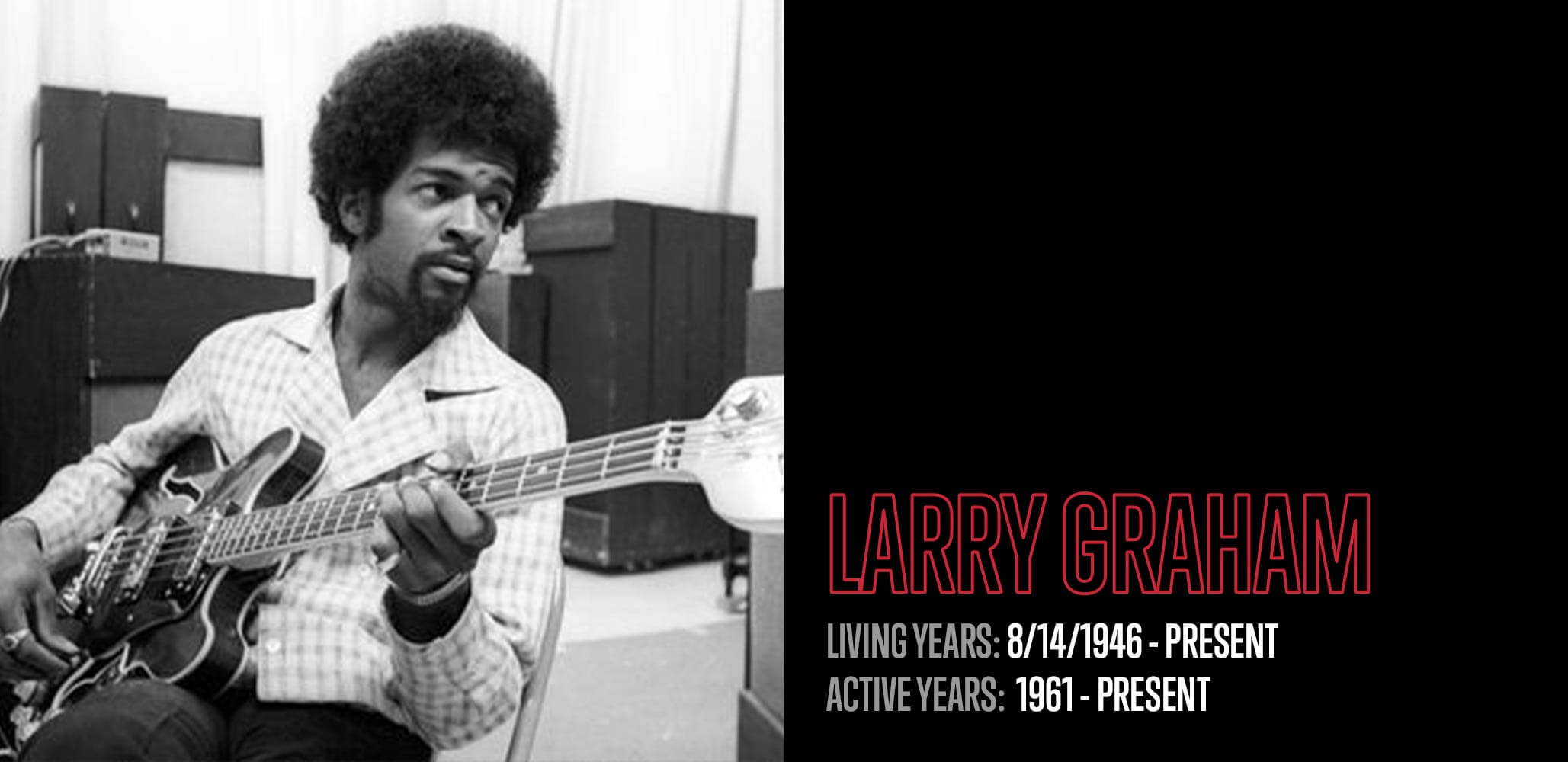
Instrument
Bass
Genres
Funk, Soul, R&B, Rock
Notable Songs
Associated Artists/Acts
Sly and the Family Stone, Graham Central Station, Betty Davis, Prince
Biography
As a member of the groundbreaking Funk Rock band Sly and the Family Stone, Larry Graham originated the “Slap and Pop” bass technique, making him one of the most influential bass guitarists in history. His percussive technique that emulates and reinforces the sound of the kick and snare drums is the foundation of Funk music.
Graham was born in Texas and played bass in his mother’s band. From 1966-1972 he played with Sylvester “Sly” Stone in Sly and the Family Stone, the first successful bi-racial rock band that included both men and women. Sly and the Family Stone combined Rock, Funk, Soul and Psychedelia, and topped the charts with hits such as “Dance To the Music”, “Thank You (Falettinme Be Mice Elf Again)”, “Stand” and “Everyday People”.
In the 1970s, Graham left Sly and the Family Stone and started his own group Graham Central Station. They had a hit with the ultra funky song “Hair”, which has been cited by Thundercat as one of his favorite bass lines. Graham also played with Prince in the late 90s and was a mentor to Prince throughout his career.
Graham has influenced countless generations of bassists including Bootsy Collins, Flea, Victor Wooten and Les Claypool, just to name a few. Graham is also the uncle of Canadian rapper/singer Drake. He was inducted into the Rock and Roll Hall of Fame in 1993 as a member of Sly and the Family Stone.
Technical Innovations
Originator of the “Slap and Pop” bass technique
Historical or Cultural Context
Was part of Sly and the Family Stone, Rock’s first successful integrated band
Artists/Acts He Influenced
Flea, Marcus Miller, Bootsy Collins, Thundercat, Stanley Clarke, Les Claypool, Victor Wooten
This article was last updated in September, 2020.



